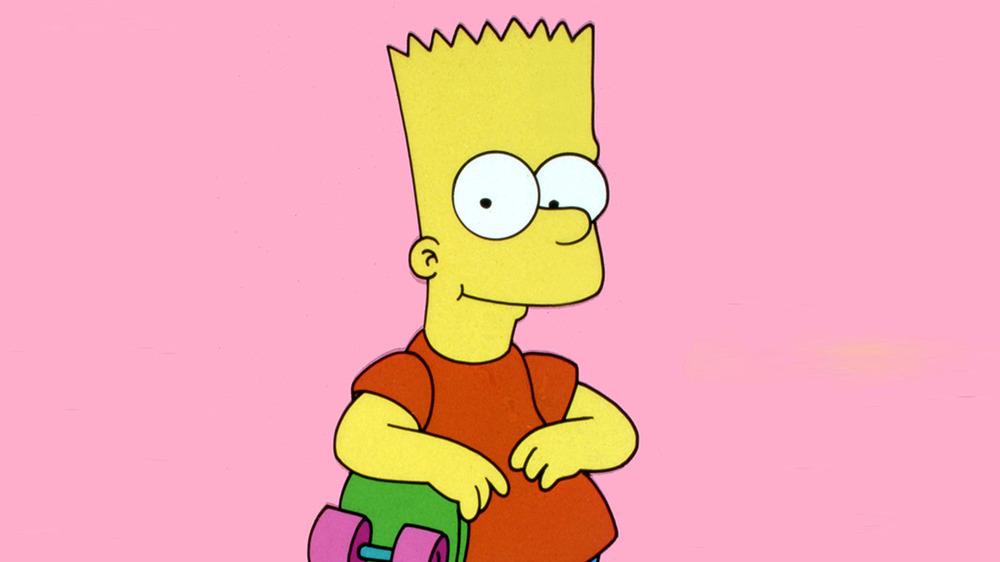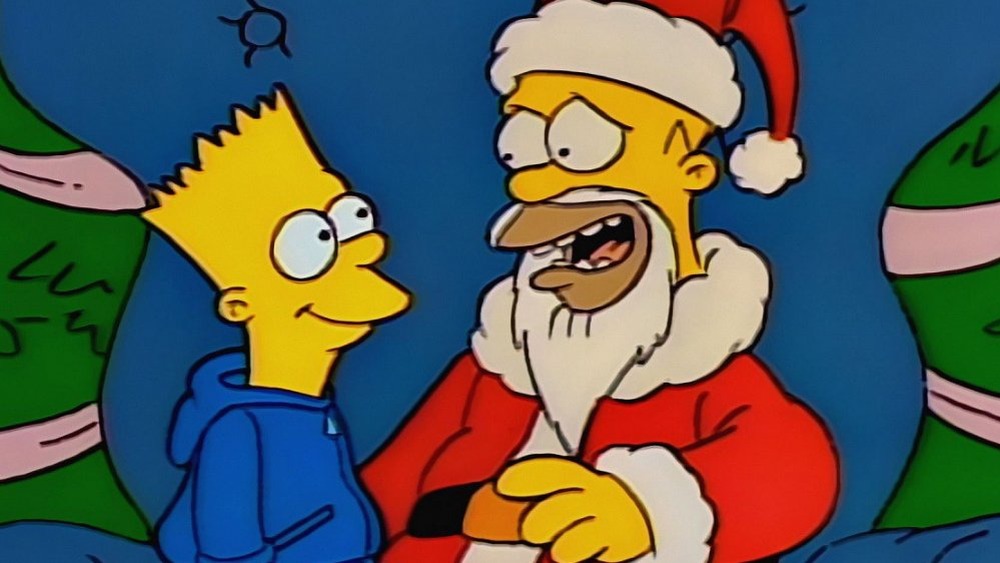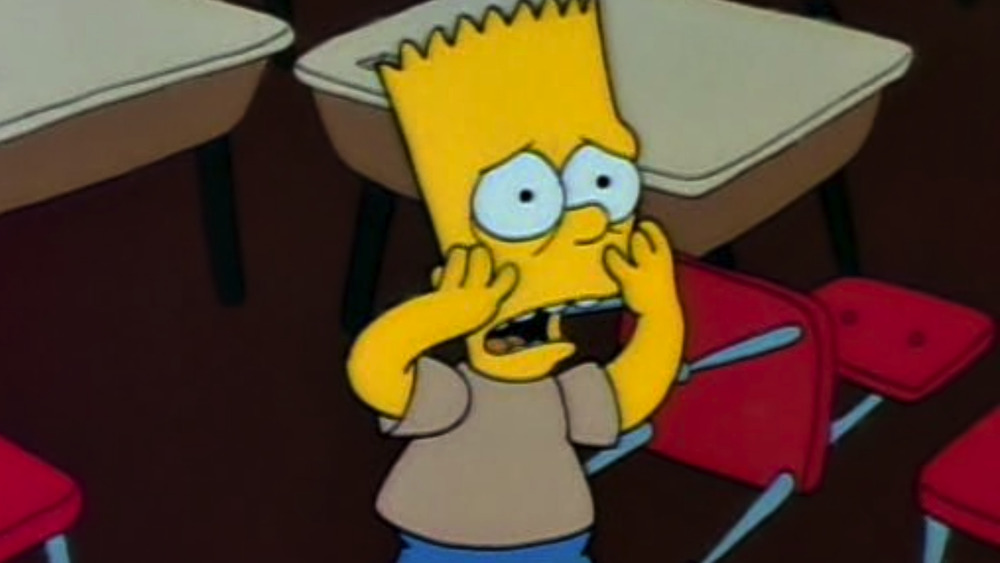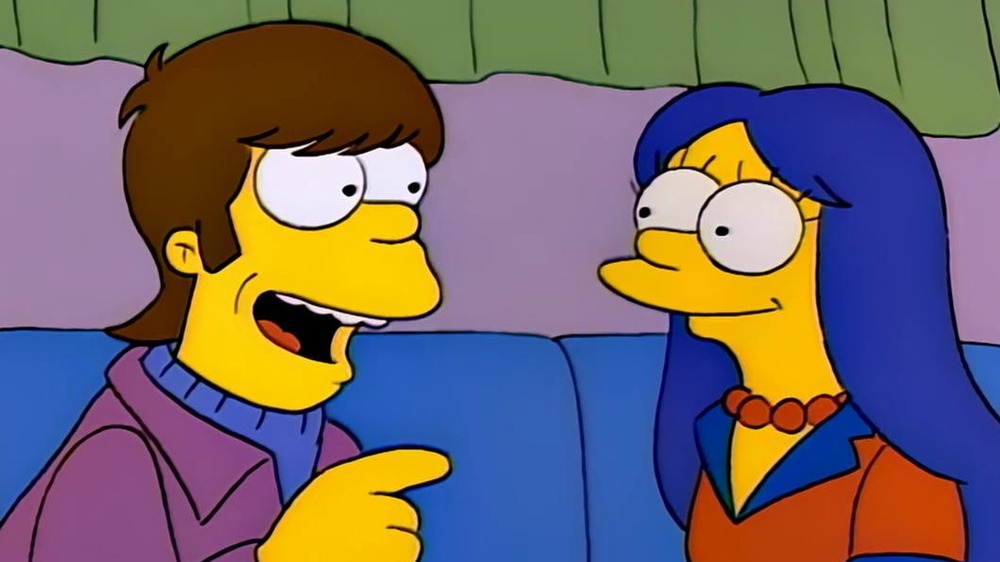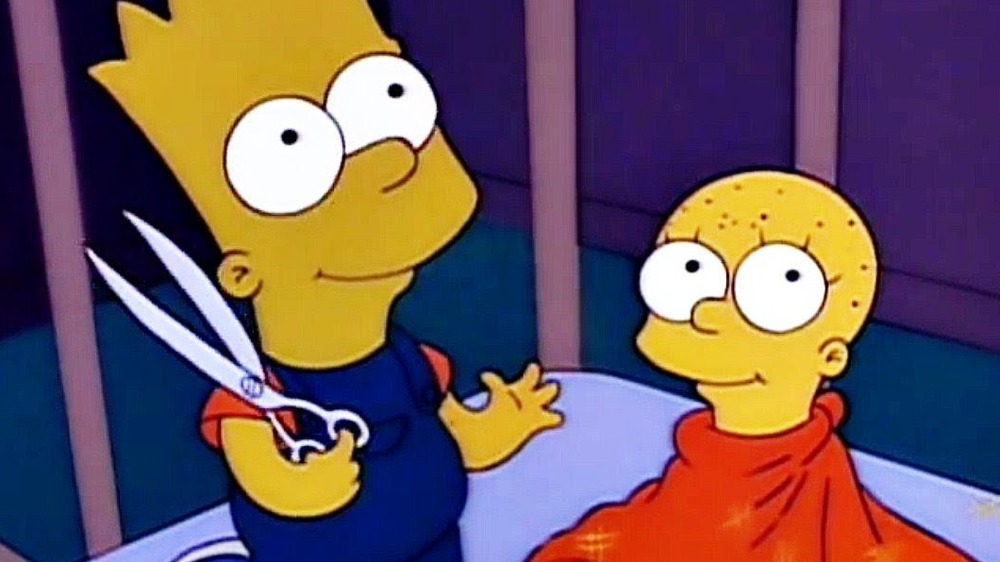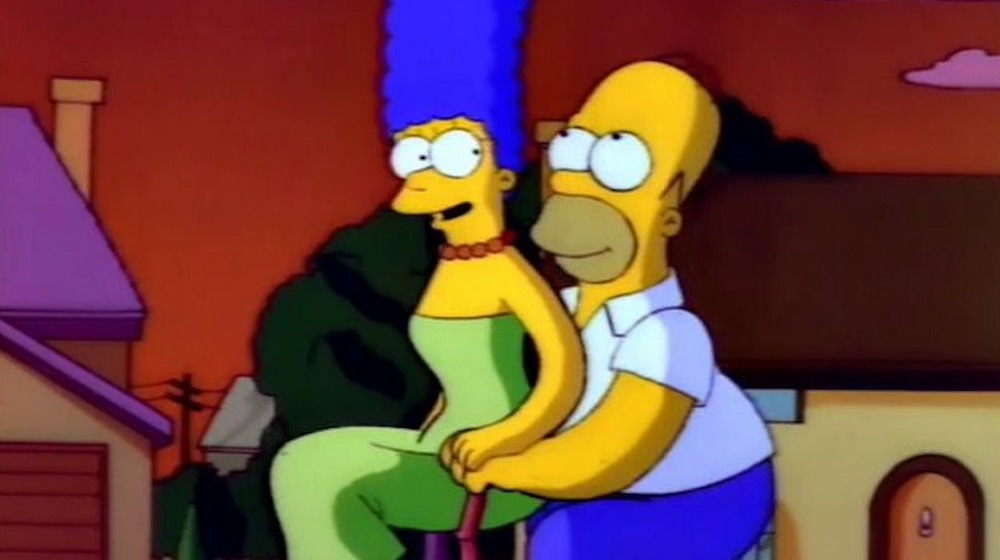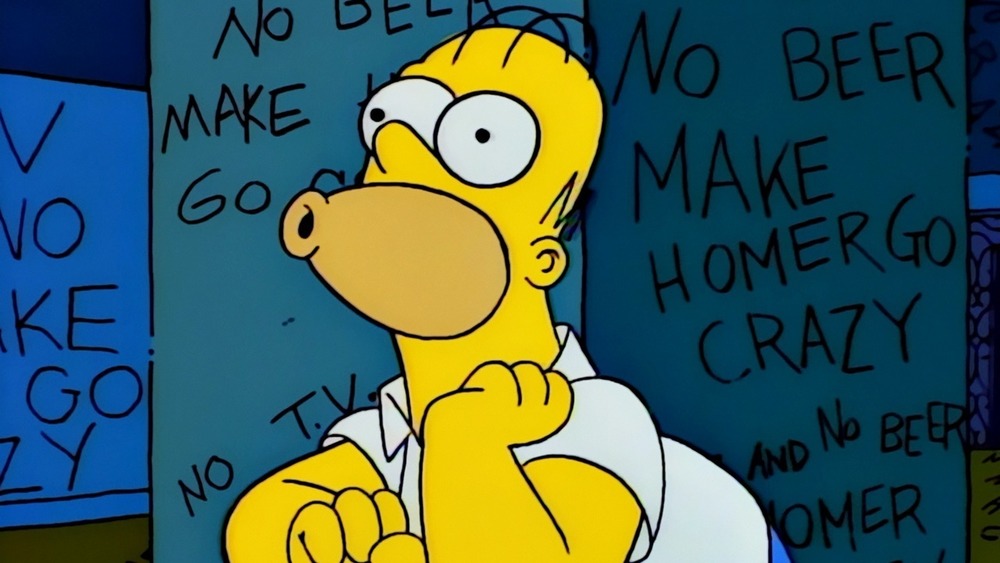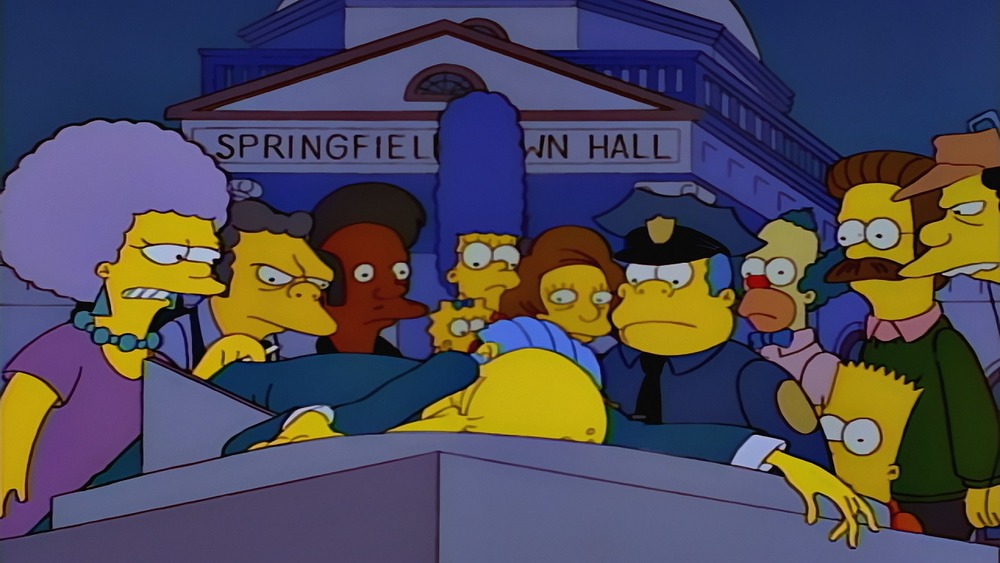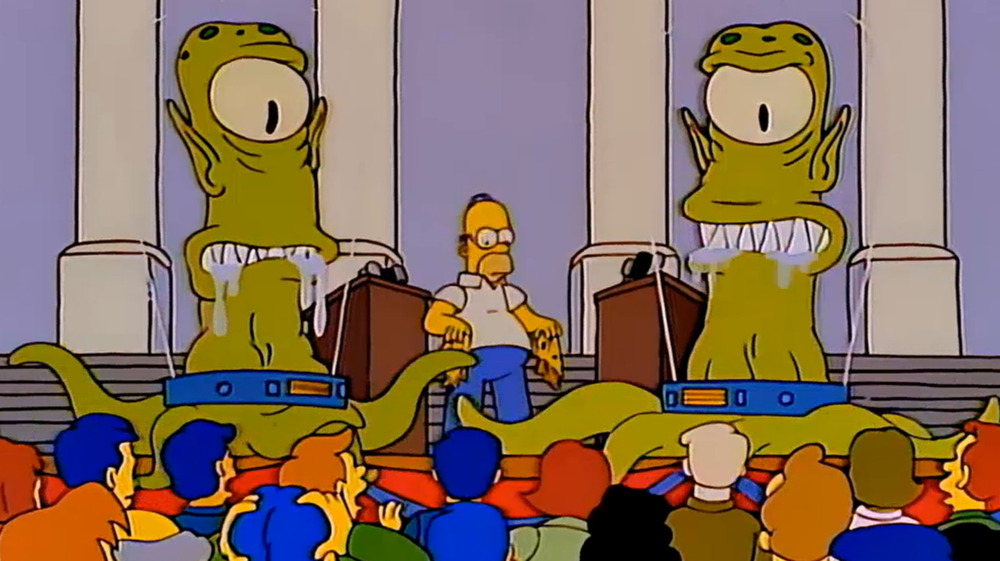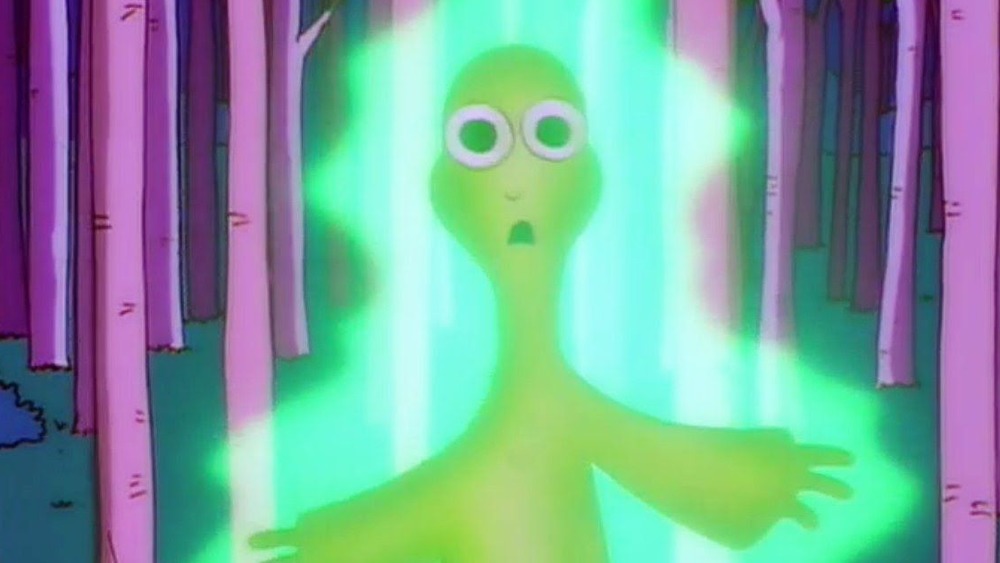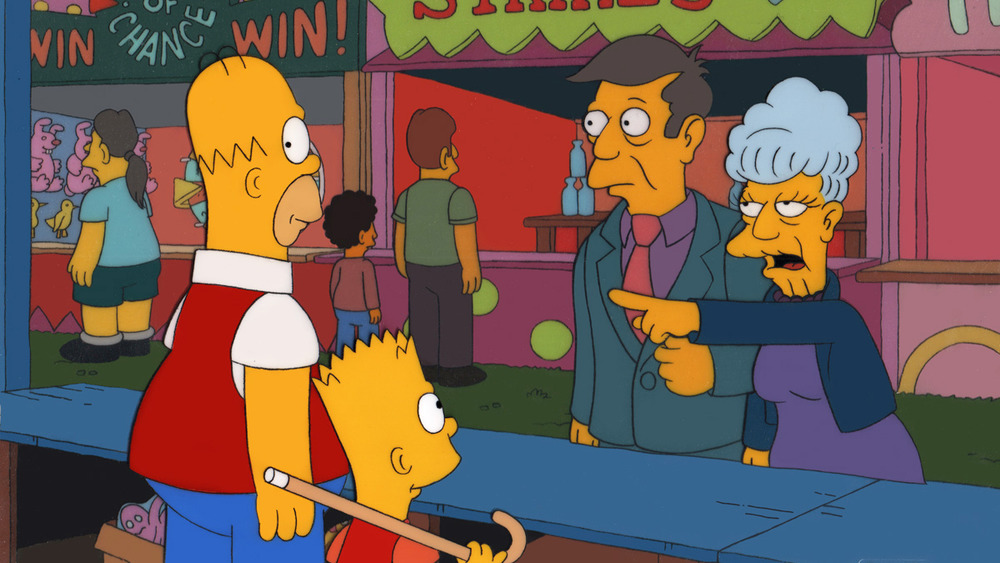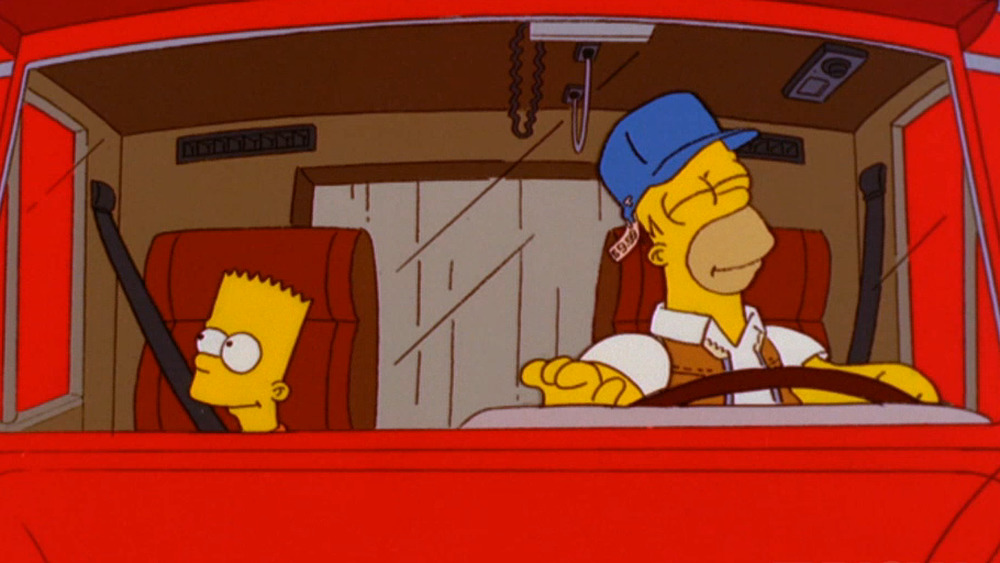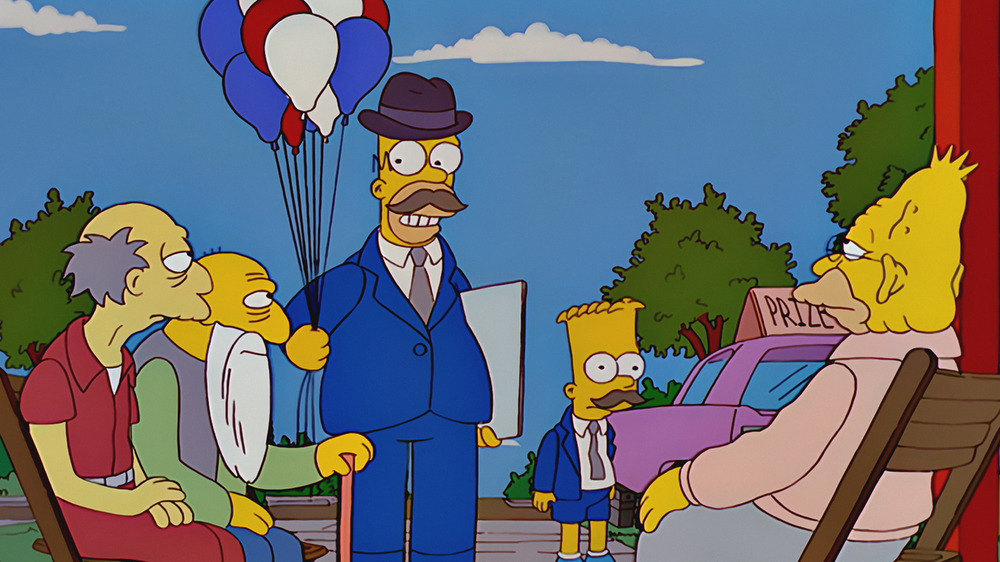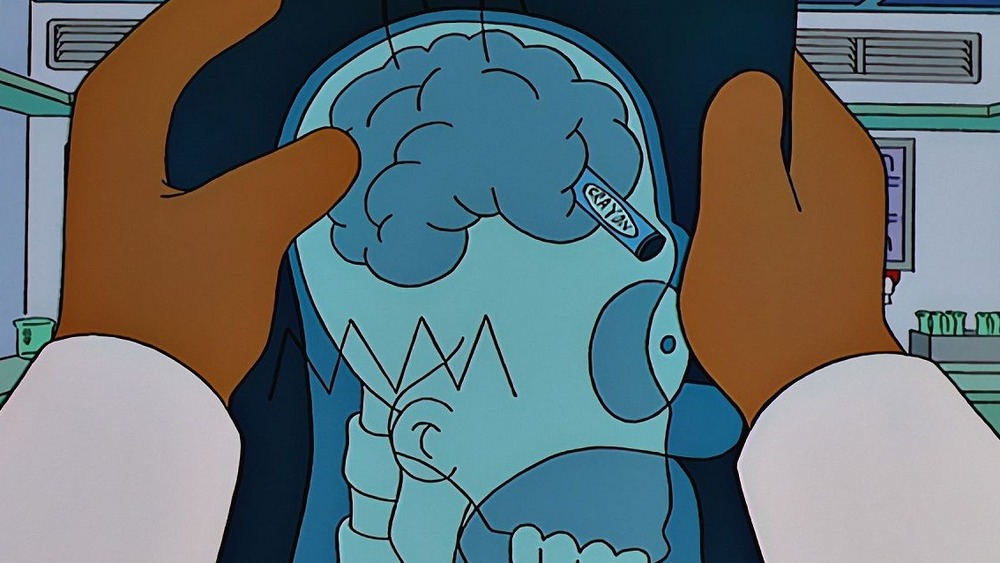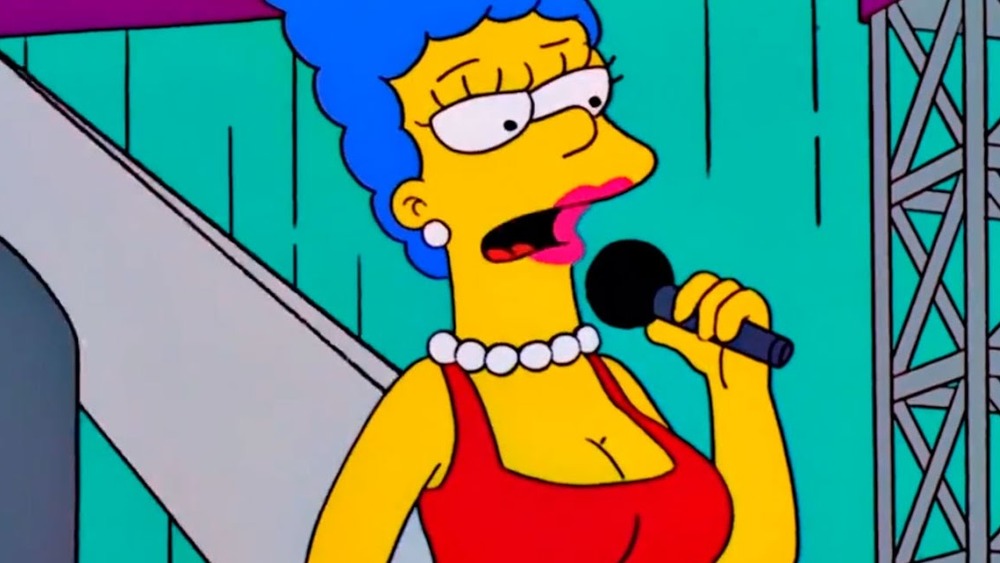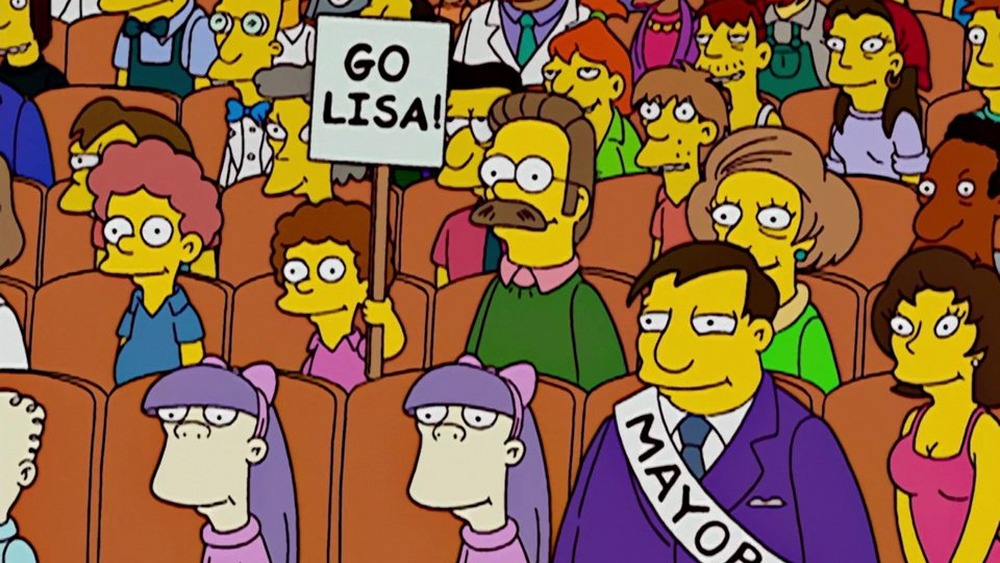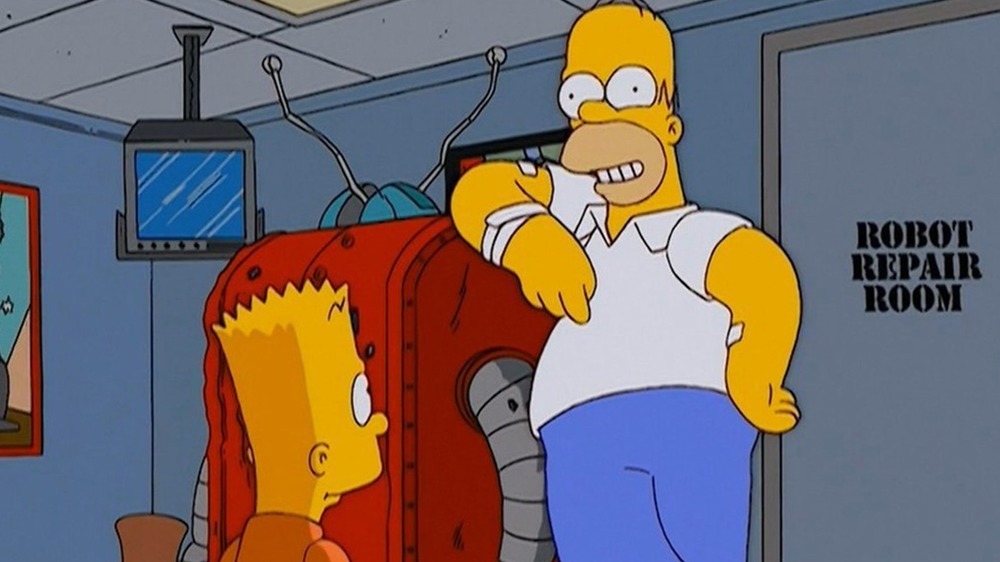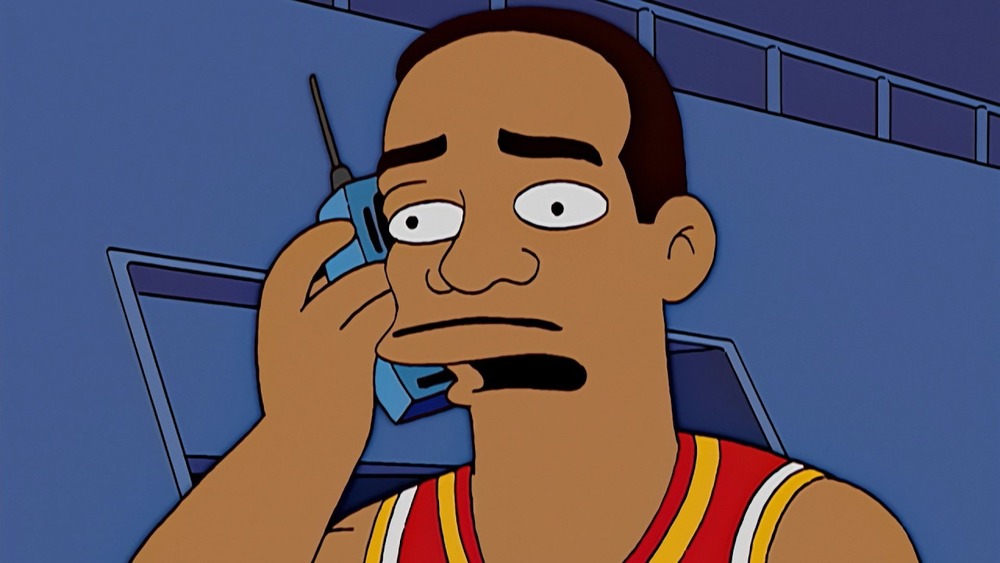The Most Popular Simpsons Episode The Year You Were Born
Not only is it among the most recognizable, acclaimed, and influential shows in history, The Simpsons has just flat-out been on television for a really long time. With around 700 episodes produced to date, the show has put out over 30 separate seasons – and that doesn't even count the stack of Simpsons shorts that aired as interstitials on Fox's The Tracey Ullman Show in the late 1980s. All told, The Simpsons has been airing on Fox (with reruns on local stations, cable, and on Disney+) for well over three decades. Let that sink in: The Simpsons is almost as old as its own never-aging main character, Homer Simpson.
The Simpsons has been around for so long, in fact, generating a plethora of memorable jokes, bits, scenes, memes, and iconic pop culture moments, that Simpsons episodes can be used to mark the passage of time. Episodes are firmly rooted in the years in which they first aired, either through explicit references, or in the minds and hearts of viewers, who will never divorce certain episodes from who they were when they debuted. In honor of the show's longevity, we propose a new sort of horoscope: One based upon the most popular episode of The Simpsons in one's birth year. These are those ratings-grabbing installments, from 1989 to 2005.
1989: Simpsons Roasting on an Open Fire
The most popular episode of The Simpsons to air in 1989 was also the only episode of The Simpsons to air that year. The episode in question is "Simpsons Roasting on an Open Fire," also known as "The Simpsons Christmas Special," which is the very first full-length episode of the now longest-running show in primetime history. The Simpson family had been appearing in short, crudely-animated segments on Fox's The Tracey Ullman Show since April 1987, but "Simpsons Roasting on an Open Fire" was their first true standalone adventure. It's a classic Simpsons tale, one that combines a story about Homer bumbling through life in order to make his family happy with a lot of embarrassingly relatable moments, hilarious disappointments, and cutting satirical humor.
A Christmas celebration is in jeopardy for the cash-strapped Simpsons when power plant owner Mr. Burns chooses fat executive raises over holiday bonuses for employees like Homer. Homer doesn't tell Marge, because she's got a big jar of money stashed away in her blue beehive ... which she has to use on laser skin surgery after Bart gets an unauthorized tattoo. Forced to take on emergency secondary employment, Homer becomes a lackluster mall Santa, and takes the paltry $13 he earns to the dog track, where he promptly loses it all. Happily, however, he wins the day by finding the perfect Christmas gift in rejected greyhound Santa's Little Helper.
1990: Bart Gets an 'F'
In 1990, The Simpsons was just about the hottest thing on television. Primetime TV hadn't enjoyed a successful animated series in decades, while viewers had never seen a family sitcom as defiantly frank and cuttingly funny as The Simpsons. This family's flaws, dysfunction, and realism propelled them to massive popularity. Bart Simpson quickly became the breakout star: The self-proclaimed troublemaker appeared on countless T-shirts, rapped on the hit novelty song "Do the Bartman," and served as the centerpiece of the show's second-season premiere, "Bart Gets an 'F'," the most watched Simpsons episode in the Simpsons-mad year of 1990.
Appropriately enough, this installment forces Bart to reckon with his choices and his bad boy ways. After improvising his way through a book report on Treasure Island (which he didn't bother to read), then cheating off of Milhouse on a test (for which he didn't study), the school psychiatrist tells Homer and Marge that it would be best for Bart to repeat the fourth grade. Dead set against that, he endeavors to improve his marks, and gets class brain Martin to tutor him in exchange for popularity lessons. After pushing himself to study, even through a snow day, Bart triumphs in school and does well enough on a history test to pass — though he barely scores a D minus.
1991: The Way We Was
Viewers can ascertain from clues in early episodes of The Simpsons that Homer and Marge Simpson are in their late 30s, and had met at Springfield High School. The 1991 flashback episode "The Way We Was" provides a lot more detail by depicting the story of Homer and Marge's first days as a couple. The idea of a '70s-set Simpsons episode featuring young, bellbottoms-sporting Homer and Marge was irresistible, and "The Way We Was" wound up as the series' most-watched episode of 1991.
Back in 1974, high school senior Homer lands in detention yet again for smoking in the boys' room. Studious and upstanding Marge winds up there for the first time, because she burned a bra at a feminist rally. When she walks in, it's love at first sight for Homer, and he vows to get her to love him back, and also go to the prom with him. To get close to her, Homer hires Marge as his French tutor, despite not actually taking that class. After an undeniable chemistry develops between them — and she accepts his prom invite — he lets slip that he lied about French. Marge goes to the prom with handsy nerd Artie Ziff instead, standing up Homer who somehow thought she'd still attend with him. At the end of what ends up being an awful night for them both, Marge picks up Homer off the side of the road, and they share their first, fate-sealing kiss.
1992: Lisa's First Word
The title implies that this 1992 episode prominently features Lisa Simpson as a baby, and indeed it does. But the real draw here, and probably the reason why enough people tuned in to make this the most-watched Simpsons episode of the year, is a milestone in the life of Maggie Simpson. In the run-up to this episode's airing, Fox heavily hyped the fact that Hollywood legend and two-time Academy Award-winner Elizabeth Taylor would guest star as Maggie Simpson. The baby famously never speaks, and the uttering of her first words was poised to be a TV event. But "Lisa's First Word" takes its time getting to that moment. The installment is primarily a flashback episode to 1984, when Bart was a difficult toddler and a reluctant older brother to baby Lisa.
We begin with the Simpsons' move into their home on Evergreen Terrace. Bart is forced to contend with a creepy clown bed, as he must give up his crib for Lisa. The new addition gets so much of his parents' attention that Bart threatens to run away, but is stopped forever when Lisa says her first word: "Bart." At the end of the episode, the action returns to the present, where Homer puts Maggie to bed, telling her he's in no rush for her to speak, as that means she'll eventually talk back. After he closes the door and leaves, Maggie removes her omnipresent pacifier, and, with the voice of Elizabeth Taylor, says simply, "Daddy."
1993: Duffless
Homer Simpson is a man of simple and identifiable tastes: He likes to watch TV, eat junk food, snuggle with Marge, and drink as much beer as he can, either at home or at Moe's Tavern, until the alcohol shuts off his brain for the night. Thus, Homer floats through life, enjoying those things that bring him pleasure and rarely facing the consequences for his tendency to overindulge. But in "Duffless," the single most-viewed episode of The Simpsons in 1993, Homer pays the price for his love of beer.
One day, Homer sneaks out of work to take the Duff Brewery tour with Barney. Naturally, they both consume some beers, rendering Barney physically unable to drive. Homer, buzzed but not as drunk as Barney, agrees to drive them home, and is immediately busted by Chief Wiggum, who arrests Homer. Charged with drunk driving, he's forced to attend traffic school and Alcoholics Anonymous meetings, and is stripped of his license for a month. Marge, worried about Homer's addictive behaviors, thinks giving up beer for a month might be a good idea for him. He reluctantly agrees, and though it's difficult, he eventually succeeds. In the process, he saves $100 and loses so much weight he no longer sweats while eating. At the conclusion of the month, he even resists his pull towards beer once more, opting to go on a bike ride with Marge rather than hang out with the sad barflies at Moe's.
1994: Treehouse of Horror V
The Simpsons' annual Halloween specials, which consist of three unrelated, non-canonical tales of horror, science-fiction, and weirdness that are often also a spoof of a well-known movie or TV show, are a TV tradition that endures today. In 1994, the phenomenon reached critical mass as that Halloween season's Simpsons entry, "Treehouse of Horror V," ranked as the most viewed episode of the entire calendar year. It's no mystery as to why: Its three segments are among the funniest, most memorable, and even most frightening of all the "Treehouse of Horror" segments ever produced.
In "The Shinning," a parody of horror classic The Shining, Mr. Burns hires the Simpsons to be the winter caretakers of his lodge, but makes sure to get rid of all the beer and TV sets, sending Homer into a murderous rage. In "Time and Punishment," Homer tries to fix the toaster and accidentally turns it into a time-travel device. After going back too far and squishing a prehistoric creature, he zaps through various messed-up timelines, including a Ned Flanders-ruled dystopia and a world where donuts rain down from the sky. The episode finishes out with "Nightmare Cafeteria," wherein Principal Skinner solves his overcrowded detention hall problem by helping Lunchlady Doris solve her underfunded lunchroom problem: They engage in the murder and cannibalism of Springfield Elementary students.
1995: Who Shot Mr. Burns, Part 1
Although the show is about yellow-skinned cartoon people who never age, The Simpsons is one of the most realistic shows on television, featuring relatable characters acting in true-to-life (well, mostly) ways. For example, millions of viewers can relate to having a boss as greedy and self-serving as Homer's, Springfield Nuclear Power Plant owner C. Montgomery Burns. The 1995 episode "Who Shot Mr. Burns, Part 1" demonstrates just how over-the-top evil the frail and wicked energy tycoon can get.
After oil is discovered under Springfield Elementary School, bringing much-needed funds to the poorly-resourced institution, Burns steals the lucrative crude with "slant drilling." Not only does he destroy large parts of Springfield in the process, including Moe's Tavern and the Springfield Retirement Castle, he locks up a monopoly on energy, forcing the whole town to get their power from Burns' sources. He further ensures his dominance by eliminating all natural light, building a huge disc to block out the sun. By the end of the episode — a season-ending cliffhanger, which is the first half of a two-part episode — Mr. Burns has been shot, and is barely clinging to life while sprawled out on a sundial. He did make a lot of enemies in this odd, vengeful town, after all — it was only a matter of time.
1996: Treehouse of Horror VII
Two years after scoring some of its biggest Halloween ratings ever, another Simpsons' fright-fest, "Treehouse of Horror VII," scored enough viewers to rank as the top episode of 1996. Interest may have been juiced somewhat by the fact that this was a presidential election year in the United States, with attentions turned to the race between incumbent Bill Clinton and Republican challenger Bob Dole. The Simpsons, always a satirical show, made fun of both candidates in this Halloween episode by having recurring alien invaders Kang and Kodos kidnap the two men, take over their bodies, and run in their stead. As they point out, after Homer exposes them, the United States has a two-party system, so Americans have to vote for one of them — and then wind up enslaved. In the anthology episode's other two segments, Lisa's tooth-in-a-Petri-dish experiment leads to a tiny, rapidly evolving society, and the family meets Hugo, Bart's monstrous, presumably evil, fish-head-devouring, formerly conjoined twin brother, who's been kept chained up in the Simpson family attic.
1997: The Springfield Files
Fox was responsible for more than a few hits that dominated pop culture in the 1990s, among them Melrose Place and Beverly Hills, 90210. But only one super-hot drama dared crossover with The Simpsons: The X-Files, the creepy show about FBI agents Fox Mulder (David Duchovny) and Dana Scully (Gillian Anderson). Bringing those two characters (voiced by their original actors) to The Simpsons was, at its core, a ratings-boosting publicity stunt, and it worked like gangbusters: "The Springfield Files" was the most-watched episode of the animated series for the entirety of 1997.
One night, a very drunk, breathalyzer-failing Homer walks home from Moe's Tavern and stumbles into the woods, where he comes face to face with something utterly unexplainable: A wispy, glowing, big-eyed creature resembling popular depictions of aliens. The entity wishes no harm to Homer, but that doesn't make it any less terrifying. News of the encounter reaches Mulder and Scully, and they journey to Springfield to solve the case. Once again, the creature appears in the woods, and once more horrifyingly proclaims peace. Bart catches footage of the event on video. Eventually, it's not the X-Files duo that cracks the case, but Lisa. She makes Mr. Smithers come forward to explain that the presumed alien is actually the elderly and decrepit Mr. Burns, whose weekly life-preserving medical treatments leave him confused and disoriented. The glow just comes from working around nuclear power for as long as he has.
1998: Bart Carny
Over the course of hundreds of episodes, The Simpsons has cracked jokes at the expense of nearly everyone and everything that factors into American life, no matter how big or how small. In "Bart Carny," the best-performing Simpsons episode of 1998, the show goes after a familiar slice of sketchy Americana: Traveling carnivals and the people who run them.
The carnival comes to Springfield, much to the delight of Homer Simpson and his kids. Bart gets himself embroiled in trouble pretty quickly when he hijacks the carnival's proudly displayed limousine, which once belonged to Hitler, and smashes it into a tree. To pay for the damages, Bart and Homer become carnival workers, or "carnies" as they're often called. Under the tutelage of father-son carnie duo Cooder and Spud, the Simpson guys learn all about fixed games and police bribes, although Homer fails to properly pay off Chief Wiggum. That gets the game Cooder and Spud work (and also live in) shut down. Taking pity on them, Homer invites them to stay with his family. He shouldn't have trusted these two carnival folkies — they temporarily steal the house and assume ownership after sending the Simpsons on a boat ride.
1999: Maximum Homerdrive
It's no wonder that "Maximum Homerdrive" was the most-watched episode of 1999 for The Simpsons. It combines two of Homer Simpson's most persistent behaviors: Eating huge amounts of food, and taking a stab at a new job. After Lisa protests a new big-portions steakhouse called The Slaughterhouse, where customers can select the still-living cow from which they want their steak to originate, the Simpson family heads there for dinner. Homer is intrigued by a promotional stunt: Whoever can eat a 16-pound steak with all the trimmings gets it for free. He accepts a challenge from a long-haul truck driver named Red Barclay, who bets Homer that he can finish the gargantuan meal first. It ends up being a Pyrrhic victory for Red: He's the first to polish off his meal, but in the process, he dies of what Dr. Hibbert diagnoses as "beef poisoning."
Homer, taking the wrong lessons from all this, decides to complete Red's last delivery, despite not knowing how to drive a big rig truck. However, that's all taken care of when he uncovers the trucking industry's dirty little secret: Trucks are all operated via autopilot. Meanwhile, back at the Simpson house, Marge and Lisa contend with a newly installed and very defective doorbell that plays a chirpy bit of "Close to You" by the Carpenters on a loop. Doorbell store mascot Señor Ding-Dong eventually swoops in and quiets it with a single crack of his whip.
2000: The Great Money Caper
It's a little surprising that it took until The Simpsons's 12th season for amoral trickster Bart Simpson to become a full-on professional con artist. Fans were apparently eager to experience this foregone conclusion firsthand, as "The Great Money Caper" was the most-viewed Simpsons episode of 2000. It all begins innocuously enough, when Bart buys a magic kit at a magic-themed restaurant. On the way home, a sturgeon falls out of the sky (dropped by cosmonauts on the space station Mir) and crashes onto the family car, wrecking it. Homer and Bart start a busking magic act to earn money to fix it, but Homer abandons Bart after it doesn't work.
Passersby take pity on the boy, and give him money to get home. After Bart rides home in a taxi and buys himself a steak dinner, both Simpson guys realize that they could just grift people to earn money, no busking skills required. They start out where a lot of con men begin: Separating vulnerable, gullible old people from their cash at the Springfield Retirement Castle with the help of Grampa Simpson, who worked as a grifter back in the 1930s. Naturally, it all goes bad when Homer and Bart get caught by an FBI agent, who is apparently revealed to be a con man as well. Even that is a ruse, however: He is, in fact, an actor hired by Marge to teach her guys a lesson.
2001: HOMR
Everything Homer Simpson does, he does to the extreme. He clearly has a drinking problem, he's remarkably lazy, and he overeats to such an extent that he once shut down an all-you-can-eat buffet. But above all these traits is Homer's intellect, or lack thereof: He is extremely dumb. However, it's possible that this is a symptom of his brain not working like others' do — after all, this is a man whose mind has explanatory conversations with itself. The 2001 episode "HOMR" attempts to provide an explanation for why Homer is so checked out, and fans were so eager to learn how Homer got to be so Homer-like that they made it the most-watched Simpsons episode of the year.
After Homer gets a job as a medical test subject, doctors find a crayon lodged in his brain, a remnant of the time he shoved 16 of them up his nose as a child. It's surgically removed, and Homer's newly unencumbered brain finally works correctly, making him intelligent, cultured, and able to relate to brilliant Lisa for once. However, he realizes that he was much happier when he was dumb, and arranges for Moe to shove the crayon back into his brain.
2002: Large Marge
The Simpsons is widely and deservedly renowned for its verbal humor, but it's no slouch in the visual comedy department either. As it's a cartoon, anything is possible, and the Simpsons team makes good use of their lack of limitations. This is on particular display in "Large Marge," an episode from the series' 14th season, which also happens to be the most-watched episode of 2002.
"Large Marge" is absolutely packed with silly sight gags. For example, when Lisa wins a bet with Homer and gets to choose their Daddy-Daughter Day activity, she has them build houses for Habitat for Humanity. They join ex-presidents Jimmy Carter, Bill Clinton, and George Bush, who engage in Three Stooges-esque physical comedy and violent slapstick. Homer removes what he says is his wedding ring — actually a tinfoil-wrapped bandage, as his real ring was eaten by a turtle — to avoid doing damage to it while working. Homer then demonstrates how Marge birthed Bart to two women at the site — only for Marge to drive by and think that Homer is flirtatiously flexing his muscles. Thinking he's losing his passion for her, Marge decides to get liposuction, only for the surgeons to mess up and provide the episode's most striking visual gag: Marge gets breast implants by mistake. As can happen in a place like Springfield, that leads to a modeling gig for Marge at the Shoe Expo, and an incident of flashing, which saves the day during a subsequent near-fatal elephant incident.
2003: I'm Spelling as Fast as I Can
Two crazes simultaneously pass through the greater Springfield area in "I'm Spelling as Fast as I Can," both of which lead to some outlandish, ill-conceived behavior: A mania for Krusty Burger's Ribwich, and spelling fever. The public's real-life obsession with McDonald's McRib sandwich and their lingering memories of childhood spelling bees likely played a part in making "I'm Spelling as Fast as I Can" the most-watched Simpsons episode of 2003.
Homer gets addicted to the Ribwich, a sandwich whose meat source is alarmingly couched in secrecy. He joins a group of "Ribheads" who travel around to different Krusty Burger locations according to the sandwich's rolled-out release schedule, not unlike the Grateful Dead's legion of "Deadheads." Homer's new adventure in gluttony comes to an abrupt end when Krusty announces that the Ribwich will be discontinued, as the animal from which it's derived has gone extinct.
Meanwhile, super-smart Lisa Simpson quickly rises through the ranks of the Spellympics, center of the cutthroat world of competitive spelling. Writer George Plimpton (voicing himself) asks Lisa to throw the finals to popular, marketable competitor Alex, a cute little boy with a speech impediment. If she does so, he promises her a college scholarship and a hot plate. Lisa sticks to her incomparably high morals and announces during the Spellympics that she was asked to rig the contest. She then defiantly continues to compete ... and misspells her word, knocking herself out of the finals.
2004: I, (Annoyed Grunt)-bot
Robot fighting is an ongoing pastime for thousands, but in the early 2000s, the pursuit enjoyed a major mainstream moment. BattleBots aired for five seasons on millennium-era Comedy Central, in which home-built, remote-controlled, weapon-packed robots squared off in an arena until one absolutely pummeled, chopped, sliced, and burnt the other into a pile of charred bits. The Simpsons tapped into this fad in 2004, and it paid off — the robot fighting-themed episode "I, (Annoyed Grunt)-bot" went down as its most-watched episode of the year. That mouthful of a title is more properly pronounced as "I D'oh! Bot," a play on I, Robot: Simpsons scripts sub in "annoyed grunt" for Homer's exasperated "D'oh!"
After he poorly assembles Bart's new bicycle, Homer decides to make it up to him by constructing a battle-bot to compete on the TV show Robot Rumble. He's not the most talented engineer, however, and resorts to crafting a glorified robot costume. He places himself inside, then goes on television and earns many violent beatdowns from many violent robots.
2005: Homer and Ned's Hail Mary Pass
The Super Bowl is often the most-watched individual TV broadcast of the year, and the show that follows the big game scores similarly blockbuster ratings. In 2005, Fox had the rights to the NFL's title game, and gave The Simpsons, its long-running cash-cow, the honor of airing a special episode right after the celebrating players left the field. That installment, "Homer and Ned's Hail Mary Pass," seems made precisely to retain as many sports fans as possible, and even revolves around the Super Bowl.
When a video of Homer doing a victory dance after winning a carnival game goes viral, several prominent athletes hire him to choreograph their own celebratory dances and post-touchdown celebrations. LeBron James, Yao Ming, Michelle Kwan, Warren Sapp, and Tom Brady all put in a request, and are all voiced by their real-world selves. Homer's dances grow into such a cultural phenomenon that he wins a plum gig organizing the Super Bowl halftime show. He recruits Ned Flanders to help him out, seeing as how his pious neighbor has been making a name for himself making extremely violent biblical films. Thus, Homer and Ned re-create the story of Noah's Ark in a football stadium. It doesn't go over well.
